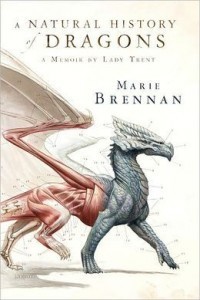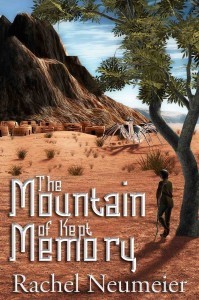Rachel Neumeier's Blog, page 367
July 16, 2014
Dragon Art –
Wow, tons of dragons over at tor.com this morning.
I scrolled rather briskly down the whole list, and I must say, either: a) lots of artists like monochrome; or b) lots of artists feel monochrome is somehow especially suitable for dragons.
Not me! I like color, movement, realism, and non-evil dragons.
It’s still hard to beat Michael Whelan’s dragons, but I do like this one by Heather Theurer a whole lot:
I clicked through to look at Theurer’s website and galleries. She does good horses and other animals, too. I particularly like her pencil drawings of the elk and moose.
Anyway, back to dragons! Marie Brennen’s Natural History of Dragons is here. So is one of Julie Dillon’s dragons. In fact, I bet you’ll recognized quite a few of the dragons in this post.

July 15, 2014
Writing a page-turner
Chuck Wendig has a good post up about the sorts of things that create a real page-turner of a book. As always from Chuck, fun to read. Not that I think advice, even good advice, is terribly helpful to a writer, but then I’m totally a do-it-by-feel-and-then-tweak kind of writer, personally. I have a hard time imagining the kind of write-by-the-numbers thing that would allow someone to actually take advice. Even, as I say, good advice.
But it’s still a fun post to read.
This is my favorite bit:
Point To The Shoe: “That’s Gonna Drop,” You Say
Sometimes it’s not about surprise. Sometimes it’s about spoiler alerting your own story. “Heather dies in seven days.” You’re giving away the end of the magic trick. You’re saying: “I’m going to turn this donkey into a bushel of mangosteens.” You just gave away the ending — or, at least, gave away something that’s going to happen. You’re pointing to the Sword of Damocles dangling over our heads and saying: “This shit right here? It’s totally going to fall. Head’s up. Like, literally.” And then you get to spend the story showing us how. It’s a tease, a hook, a taste — and if it pleases, the desire to want more will power them to turn pages oh-so-quickly.
I can think of two really good examples off the top of my head:
THE RAVEN BOYS by Stiefvater, which opens like this: Blue Sargent had forgotten how many times she’d been told that she would kill her true love. And then the short prologue finishes by adding, And Neeve added before Blue could answer, “This is the year you’ll fall in love.”
Quite a shoe. It doesn’t drop in this book, either. I haven’t read the sequel, but I bet this particular shoe isn’t going to drop till the last book. Anyway, there’s an example of a good prologue, as well as Sword of Damocles.
I expect a lot of you have read THE RAVEN BOYS, but I’m not sure this next example got as much buzz.
This is THE DEATHDAY LETTER by Hutchinson, which also starts with a (very) short prologue, like so: The first thing you need to know about Oliver Travers is that at the end of this story he’s going to die. There’s no twist of fate that save him, no deus ex machina, no deal with the devil that changes what’s inevitably going to occur. He’s going to croak and that’s just how it is. But this story isn’t about Oliver Traver’s death, it’s about his life, and the best person to tell that story is Oliver.
This is a unusual YA story. Here’s the teaser at Amazon:
Oliver lives in a world where at some point in their lives, everyone receives a Deathday Letter, a letter that kindly lets you know you have twenty-four hours left to live. Abraham Lincoln received one, Heath Ledger received one, and on an otherwise typical Thursday morning, fifteen-year-old Oliver Travers receives one. Bummer.
With his best friend by his side, Ollie has one day left to live life to the fullest, go on every adventure possible…and set things right with the girl of his dreams.
Interesting concept, nicely handled. It is in fact a page-turner of a story. Have any of you read this one? I liked it quite a bit — and I do think it’s a page turner.

Past Reading: An Interior Life by Katherine Blake
Published in 1990 and never re-issued, AN INTERIOR LIFE is one of those (many) good stories that has become all but invisible, buried in the heaps and piles and mountains of newer releases.
However, it’s still available used via Amazon, I see. Many copies are going for just pennies, though evidently you can pay upwards of $40 if you really want to. Luckily my copy is in fine shape. As far as I know, Katherine Blake never published anything else.
Oh, hey, I see on Goodreads that another commenter says: Jo Walton had recommended it and that the author was Dorothy J. Heydt.
Looking up Dorothy Heydt, I see she has written in the Darkover universe and that she has a standalone called A POINT OF HONOR, which in fact seems to mix contemporary with fantasy in yet another way. That’s interesting. *Buys copy*.
As it happens, AN INTERIOR LIFE recently came up in some comment thread somewhere, sorry, don’t remember where, but in a general “I’ve never met anybody else who’s heard of this wonderful book” sort of context. It is worth hearing about, so here:
Sue had two kids, one husband, a lovely home, and a boring life. Sometimes, when the PTA meeting proved that a committee is a life form with many feet and no brain, or when her husband was even more inattentive than usual, or when the realization that the kitchen would never be clean for more than two hours at a time would hit her, she just wanted to escape. To get out of her incredibly mundane world and live a little.
So she did.
And found that an active fantasy life can be a very dangerous thing . . . and very real . . .
This story is not only good, it’s unusual. It’s actually two stories that braid around each other: a story about Sue, a Typical Suburban Housewife, getting her life together and, as it were, finding herself without moving a step; and it’s also a story about Marianella and Lady Amalia, who are trying to stop the Darkness spreading over their land, and Aumery, unwilling servant of the Darkness.
So, two stories. It’s actually rather rare that a single page doesn’t contain a bit from both. Let me show you the first transition, which happens just four pages into the novel. I’m going to rewrite it just a tiny bit so it will read smoothly, since I want to show how this works without retyping the entire beginning of the novel. Anyway:
The chocolate scurf on the front burner had softened, and Sue leaned hard on the sponge and scrubbed away . . . she dropped the sponge into the bleach solution and looked out the kitchen window again. The sparrows had taken fright at a dog, cat, or toddler and flown away. The lucky stiffs. Above the pyrancantha, something glinted in the sky, a 747 maybe, or a sea gull, the sun bright on its wings, high above the sparkling sea. She stood at a white-washed wall, chest high, that ran along the top of the cliff north and south from the sea-keep. She could feel the grittiness of the mortar under her fingers, and the pressure against her breasts as she leaned far over the wall to see the shore below. A strip of clean sand ran along the cliff’s foot, smooth and white.
Sue is now in the persona of Marianella, who has just arrived with Lady Amalia at the abandoned keep. The story is going to shift back and forth from this point on, but the lines between the worlds are going to blur even more than the bit above makes it seem, because Marianella and Amalia comment freely on the details of Sue’s life: what she could cook for supper, what kind of dress she should wear to an important party, how to extricate herself from an awkward situation with her husband’s boss.
Sue can also peek into the other world almost at will, shifting pov between Marianella and Amalia to keep track of what’s going on. She can comment on events that are occurring there, just as the others can comment on her life. When Amalia meets a suspicious character who spins her a tall tale about his past, Sue comments, “And if you believe that, I have a bridge I can sell you.” And she knows that Amalia doesn’t believe him either, because at that moment, Sue is simultaneously in her own pov and in Amalia’s pov.
Now, the situation confronting Lady Amalia and her world is dire. Here we have a pretty standard fantasy plot: a terrible threat, heroism and last stands, romance and star-crossed lovers, all that. It’s a good enough story, but what’s surprising is how juxtaposing this story with Sue’s ordinary life makes all the tiny events of her life somehow much more interesting. Sue does confront real problems, but they are very ordinary problems. Yet reading about her life does not slow the story down or bore the reader; quite the reverse, as the reader actually becomes invested in Sue’s life at least as much as in the fate of the fantasy world. (At least, that was my experience as a reader.)
As it happens, I like a story where someone gets her life in order and comes to understand herself better and grows in confidence and realizes she does actually still love her own husband. Even so, without the fantasy story braided in with Sue’s contemporary life, the latter would be boring. But put the two stories together, and somehow Sue’s personal story becomes more interesting and appealing than the violence and adventure and heroism of the fantasy. This isn’t my favorite book ever, but it’s good. As a writer, I think it must have been fun to write. A challenge, but fun. I definitely think it’s worth picking up if you have room on your no-doubt-tottering TBR pile.

July 14, 2014
WikiHow
Something I just discovered:
Did you know there is a WikiHow page for how to write a dystopian novel? Really.
Tip number one: Think of a world-impacting topic/word/phrase that you’re passionate about. It could be pollution, politics, government control, protests, poverty or privacy – problems with the world. Any of the suggested topics could easily lead to an amazing exploration of a dystopian world within your novel.
Um, okay. I notice there is no step for “develop your skills as a writer.” Although there is one for “read extensively within the dystopian subgenre,” which does count, to some extent, I think.
There are also WikiHows for How to Write Dark Fantasy, How to Write a Credible Fantasy Story, and, I’m guessing, many other categories, but I stopped looking for them at that point.
Significantly more useful: simple but out of the ordinary tasks such as How to Remove Surgical Staples. That’s nice and clear and all I wanted to know was which which bit of the tool goes under the staple, which is plainly indicated. (This was for staples on a dog after a c-section, btw, not on myself, and no, I don’t have my own staple remover, I borrowed the vet’s spare.)
Anyway, I just got a kick out of this. I wonder who thought “writing a dystopian novel” was appropriately boiled down to seven steps on a WikiHow page?

July 11, 2014
Those moments in writing . . .
Those moments in a writer’s life when, for example, you stop for the night with this phrase:
But at that instant
I only wrote 1000 words last night, because I honestly did not know what was going to follow. Some sort of emergency or disaster which would get the main characters from HERE IN THIS SITUATION to THERE IN THAT MUCH WORSE SITUATION, but I did not know what was going to happen to kick the narrative from one state to the other.
Sometimes I do wish I wrote from a detailed outline.
Anyway, I did go on from that point this morning. Sometimes sleeping on it does actually help. I’m pretty sure who is standing there over the main character cackling evilly — she is about to look up and see them. Tonight I will have to write that bit, so I’ll find out for sure.
I’m about 220 pages along. I do know what THAT MUCH WORSE SITUATION comprises (more or less) (‘m pretty sure). And I have a vague idea how my characters are going to get out of THAT MUCH WORSE SITUATION and INTO YET ANOTHER CRISIS before they make it over the hump into the falling action.
Meanwhile, I’ve surprised myself by doing something I never thought possible: I’m rewarding myself for hitting my daily minimum with KERI by allowing myself to write 500 words or so of a SF space opera kind of thing. In other words, I’m switching from one writing project to another and back again every day.
This is weird. I honestly don’t know whether it will last. Part of what’s driving this is that I’ve been reading Mary Stewart books that are not appealing to me very much. I’m finding them boring and the main characters wimpy and, well, I’d just as soon work on something of my own as read further in these books. (Thunder On The Right and My Brother Michael are the two which I’ve found boring so far, just fyi.)
I think switching writing projects might be working for me because the two projects are so utterly different. KERI is a fairly straightforward YA fantasy. The other one (working title NO FOREIGN SKY) is an adult SF story that kind of turns H Beam Piper’s LITTLE FUZZY on its head and shoves the scenario forward a hundred years, and yes, that sounds pretty opaque now that I look at what I just typed. Okay, I mean that instead of cute teddy bear aliens being marooned and culturally smashed and then being rescued by humans, I have a human colony that was marooned and culturally smashed and then rescued by Very Big Aliens (and yes I worked out the biological and evolutionary history for the alien species (I did that ages ago)). Only, as I said, that is all in the backstory; this book is set about a hundred years after that rescue, so that the human population is fully integrated into the alien society. And now things are happening.
Anyway, don’t hold your breath. This one is only about 18,000 words along, which barely even counts as “started” in my lexicon. And I don’t know how much I’ll be working on as I go forward with KERI and then need to finish other projects. But I thought I’d mention it. Because I never got how a writer could work on multiple projects at the same time, and now I do get that.

And you thought love triangles were complicated?
Even if you think love triangles are simple (or passe, or tedious, or whatever), this is still a fun post.
Over at Epic Reads, a “study of love triangles and other emotional shapes.”
Formula: Person A likes Person B + Person C likes Person B + Person B is torn = Classic Love Triangle
Yes, that’s simple enough, right?
Well, how about this one?
Formula: Person A likes Person B + (Persons C through Y can see they’re meant to be together) + Person Z likes Person A = Vanishing Cone
I read this several times and still am not sure I have it figured out. Who’s Person Z again?
Actually, all of these are (triangle, shattered triangle, vanishing cone, selection sphere, half-remembered trapezoid) are illustrated with diagrams and with examples from YA fiction, so that makes them easier to sort out. I really enjoy the names the most! The “half-remembered trapezoid”, who came up with that, right?
I will say, of the examples give, I’ve only read THE HUNGER GAMES.
I think my own books tend to include maybe a Half-Visible Straight Line With Slight Hints of a Triangle. Mostly I think my characters are too busy saving the world to really figure out whether they’re falling in love with anybody. Not invariably, granted, but still.

July 10, 2014
Oh, here are the WFA nominees –
You know, I’m not sure how nominees are chosen for the World Fantasy Award. But here they are! I think I will probably go to the World Fantasy convention this year . . . it is in D.C. which is too far to drive, alas, because spending time in airports wondering if your flight will be on time is not my favorite thing. I haven’t actually decided to the point of getting my membership or buying plane tickets or whatever, but still, it’s been a couple of years and it would be fun to go.
Anyway! Here are all the nominees.
And here are the nominees for the novel category, which as always is the one I’m more interested in:
Richard Bowes, Dust Devil on a Quiet Street (Lethe Press)
Marie Brennan, A Natural History of Dragons: A Memoir by Lady Trent (Tor Books)
Neil Gaiman, The Ocean at the End of the Lane (William Morrow/Headline)
Sofia Samatar, A Stranger in Olondria (Small Beer Press)
Helene Wecker, The Golem and the Jinni (Harper/Blue Door)
Gene Wolfe, The Land Across (Tor Books)
A NATURAL HISTORY OF DRAGONS is the sole nominee I’ve read, and to me it seemed too much of an series introduction to necessarily look like it should win here. I loved it, btw, that isn’t the issue. The issue is, we need an award for series-taken-as-a-whole, and then I would hope to see Brennen’s story appear on a short list for that award when it’s finished. Still, I greatly admired this book and I sure wouldn’t mind seeing it hit the top spot.
I’ve heard good things about several of the other nominees.
Neil Gaiman — sometimes his writing suits me and sometimes it isn’t so much to my taste.
I’m sorry to say that I hated The Book of The New Sun and only made it a little way into it before giving up forever — and THE LAND ACROSS sounds like creepy political horror, so really not my thing.
But THE GOLEM AND THE JINNI sounds interesting:
Chava is a golem, a creature made of clay, brought to life by a disgraced rabbi who dabbles in dark Kabbalistic magic. When her master, the husband who commissioned her, dies at sea on the voyage from Poland, she is unmoored and adrift as the ship arrives in New York in 1899.
Ahmad is a jinni, a being of fire, born in the ancient Syrian desert. Trapped in an old copper flask by a Bedouin wizard centuries ago, he is released accidentally by a tinsmith in a Lower Manhattan shop. Though he is no longer imprisoned, Ahmad is not entirely free – an unbreakable band of iron binds him to the physical world.
The Golem and the Jinni is their magical, unforgettable story; unlikely friends whose tenuous attachment challenges their opposing natures – until the night a terrifying incident drives them back into their separate worlds. But a powerful threat will soon bring Chava and Ahmad together again, challenging their existence and forcing them to make a fateful choice.
This title has been quite a phenomenon, with upwards of 4400 review on Goodreads, I see, and a plus-four rating. Wow.
A STRANGER IN OLONDRIA is a bit of a quieter entry, though I’ve certainly seen reviews of it here and there.
Jevick, the pepper merchant’s son, has been raised on stories of Olondria, a distant land where books are as common as they are rare in his home. When his father dies and Jevick takes his place on the yearly selling trip to Olondria, Jevick’s life is as close to perfect as he can imagine. But just as he revels in Olondria’s Rabelaisian Feast of Birds, he is pulled drastically off course and becomes haunted by the ghost of an illiterate young girl.
In desperation, Jevick seeks the aid of Olondrian priests and quickly becomes a pawn in the struggle between the empire’s two most powerful cults. Yet even as the country shimmers on the cusp of war, he must face his ghost and learn her story before he has any chance of becoming free by setting her free: an ordeal that challenges his understanding of art and life, home and exile, and the limits of that seductive necromancy, reading.
I’m not sure this sounds as much to my taste as the GOLEM AND JINNI title. But I’ve seen good reviews for it here and there.
And the remaining entry, very much the dark horse here, I believe, is DUST DEVIL ON A QUIET STREET.
Dust Devil on a Quiet Street chronicles the remarkable life of Boston-born, New York City-reared author Richard Bowes. Bowes’s childhood and adolescent brushes with dramatic spirits and hustlers, large and small, paved the way for his adult encounters with the remarkable, the numinous, the supernatural. Deftly orchestrated, this “memoir” is part impassioned homage to Manhattan—decades before and up to its recent wound on September 11th, which creates a hole in the city and allows the ghosts of the dead to return—and part tell-all of the uncanny secrets behind a group of Greenwich Village writers and life as a university librarian.
Hmm. I hadn’t heard of that one at all. It’s the sort of thing that makes me think I should get a sample for my Kindle, though — the remarkable, the numinous, the supernatural? That sounds pretty cool. But I’ve never been into cities in general or Manhattan in particular. I can see why this would particularly appeal to, oh, possibly New York writers.
Anyway, an interesting list, and congrats to all the writers who were chosen!

July 8, 2014
The Mountain of Kept Memory: What is your book about?
What a totally unanswerable question, right? What is your book about? Here’s what people do not want when they ask that question: They don’t want to know the plot (waaaay too long and utterly boring to describe), nor do they want to know the theme (“It’s about sacrifice and finding true love”).
No.
What people actually want when they ask what your book is about is the “elevator pitch,” the one-sentence description of your book that serves as a hook and a “wow, cool” pitch for your book. One sentence is brief enough they can stand to listen to it, and who knows, it might make your book sound Just Right for Them, which is a perk.
Needless to say, coming up with a one-sentence description of your book is NOT EASY.
Here’s my attempt for MOUNTAIN: Though Erest is only a farmer’s crippled son and Oressa is on the run from her royal father, when their homeland is threatened by invaders seeking to steal the power of the last goddess in the world, they must work together to save both the goddess and the realm.
What do you think? I don’t really like it. What I like least is the “they must work together” phrase. This signals Romance Here, in my opinion, and though there is a fairly strong thread of romance through this book, it isn’t between Erest and Oressa. Plus they are mostly working separately, if you want to be nitpicky about it.
Even the 150-word back cover copy is not easy:
When Erest ventures onto the forbidden mountain of the dead gods, he finds himself snared only half-willingly into the service of the last goddess in the world. The Kieba does need help in her endless work of guarding the world from plague and disaster, but does that really have to be him?
Oressa, princess of Carastind, knows what’s important in life: avoiding her royal father and keeping track of all the secrets of his court. But when she overhears news about imminent invasion, she is shocked to discover just what her father plans to give away in order to buy peace.
But when the invaders attempt to steal the Kieba’s power, both Erest and Oressa must decide where their loyalties actually lie, and what they are willing to risk to protect the goddess, their home, and the world.
There, that’s the working copy for the back cover. Is it accurate? Well, sort of, not really, but maybe accurate enough.
It leaves a lot out, because there’s just no choice when condensing a whole 123,000 word book down to five sentences.
I’m bad at memorizing one-sentence descriptions, which is too bad, because it’s kind of convenient to be able to rattle that off when someone asks what your book is about.

July 7, 2014
Cover reveal!
Hey, check this out:
The artist is Aidana at WillowRaven, whom I hired to do the cover because I really liked the artwork she has front and center on the linked page, so click through and view it. She’s a pro with lots of experience with SFF covers, I knew she could do a good job with a landscape-heavy cover, and she did, didn’t she?
Also this, the front cover with the design and text and everything:
Now, naturally, after I had already settled the contract with the artist, I immediately started hearing about publishing options in which the service you hire includes a cover, or third-way publishers who for a percentage manage things (including the cover), or whatever. There are more options out there than I thought, and I already knew there were options! I may well be exploring multiple options this very year, since I will be dealing with the Black Dog short stories more piecemeal, not going through a publisher of any kind.
I figure probably anybody would approve this cover, though, so whether I do things piecemeal myself or go with a publishing company of some sort, I expect this will be the cover that you all see on the finished product.
Now, timing, or, when will this book actually be born?
This is a good question! I don’t know. It depends on whether I go with one service or another and how long they take, or wind up doing CreateSpace and Smashwords and whatever and how long that takes. It depends on whether I want to make copies available to bloggers and other reviewers for three months prior to release or whether I think releasing it and then doing promotion is fine or what. Aargh, lots of decisions! And I’m trying to write a different book at the same time as deal with this!
Ah, well, it will all be easier by this time next year, when I’ll know a lot more about what I’m doing. Or, shoot, the year after that, when I’ve done the self-publishing thing three different ways and have a MUCH better idea of what I’m doing. THIS year is for experimentation. Here’s hoping none of the experiments blow up in my face!

Something nice to start the week –
Ah, nostalgia. THE CITY IN THE LAKE seems so long ago. It really hasn’t been that long, though. What, six years? That does mean more like eight years since I wrote it.
The hardcover’s out of print now, you know. Except I have quite a lot of copies. One of which is up for a giveaway at Random Musings of a Bibliophile.
Brandy just read CITY and posed her review this morning. Here’s where Twitter comes in useful, because I knew she just read it and was going to post a review today, so that gave me a chance to offer a signed book for a giveaway. Even if you have a copy, shoot, drop over there and enter and you can get this signed copy and give your original copy away to a friend, so that’s a win-win for everyone right there.
I got a kick out of this bit:
I would really love to know what it is like to live inside Rachel’s head, because all of her books are distinctly different, wildly inventive, and not what I think I’m getting when I start reading. You would think by now I would stop being surprised by that, but I continue to be amazed at her creativity and how her writing style alters to fit each world she has created.
Because I feel exactly that way about other writers. I read CASTLE BEHIND THORNS and thought, How did Merrie think of this? I wish I’d written it. And the Touchstone trilogy! Except I couldn’t have written that, especially the focus on privacy issues, I wouldn’t have been able to handle that anything like as well as Andrea Host did. Remember that wonderful touch in Elizabeth Bear’s RANGE OF GHOSTS, the way the sky changes depending on who political controls a region? How on Earth did she think of that?
CITY is still (sometimes) my favorite of my own books. And sometimes not, it depends. Anyway, I’m glad to see this review from Brandy. Pop over and take a look and, if you like, enter the giveaway.









